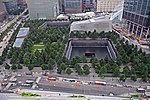Liberty Street Ferry Terminal
1865 establishments in New York (state)Baltimore and Ohio RailroadCentral Railroad of New JerseyDemolished buildings and structures in ManhattanFerries of New York City ... and 3 more
Ferry terminals in ManhattanTransit hubs serving New JerseyWater transportation in New York City

Liberty Street Ferry Terminal or Liberty Street Terminal was the Central Railroad of New Jersey's passenger ferry slip in lower Manhattan, New York City and the point of departure and embarkation for passengers travelling on the Central Railroad of New Jersey, Baltimore and Ohio Railroad, Reading Railroad and the Lehigh Valley Railroad from the Communipaw Terminal across the Hudson River in Jersey City.
Excerpt from the Wikipedia article Liberty Street Ferry Terminal (License: CC BY-SA 3.0, Authors, Images).Liberty Street Ferry Terminal
West Street, New York Manhattan
Geographical coordinates (GPS) Address Nearby Places Show on map
Geographical coordinates (GPS)
| Latitude | Longitude |
|---|---|
| N 40.7113 ° | E -74.0149 ° |
Address
West Street
West Street
10281 New York, Manhattan
New York, United States
Open on Google Maps










